University: Leadership for Quality Improvement in Healthcare Report
VerifiedAdded on 2022/09/07
|11
|2583
|14
Report
AI Summary
This report, prepared for NURS 8300, examines leadership for quality improvement in healthcare, focusing on three key rate-based measurements: Prevention Quality Indicators (PQI), Inpatient Quality Indicators (IQI), and Patient Safety Indicators (PSI). The report defines each measure, describes its importance within a clinical setting, and explores associated risks. It then relates each measure to patient safety, the cost of poor quality, and the overall cost of healthcare, providing a comprehensive analysis of how these indicators impact the effectiveness and efficiency of healthcare delivery. The analysis includes a discussion of how PQIs assess ambulatory care, IQIs evaluate inpatient services, and PSIs monitor patient safety events. The report highlights the financial implications of quality improvement and the importance of these measures for healthcare organizations. It emphasizes the value of these quality metrics in improving patient outcomes and reducing healthcare costs.

Running head: LEADERSHIP FOR QUALITY IMPROVEMENT
Leadership for Quality Improvement
Name of the Student
Name of the University
Author Note
Leadership for Quality Improvement
Name of the Student
Name of the University
Author Note
Paraphrase This Document
Need a fresh take? Get an instant paraphrase of this document with our AI Paraphraser
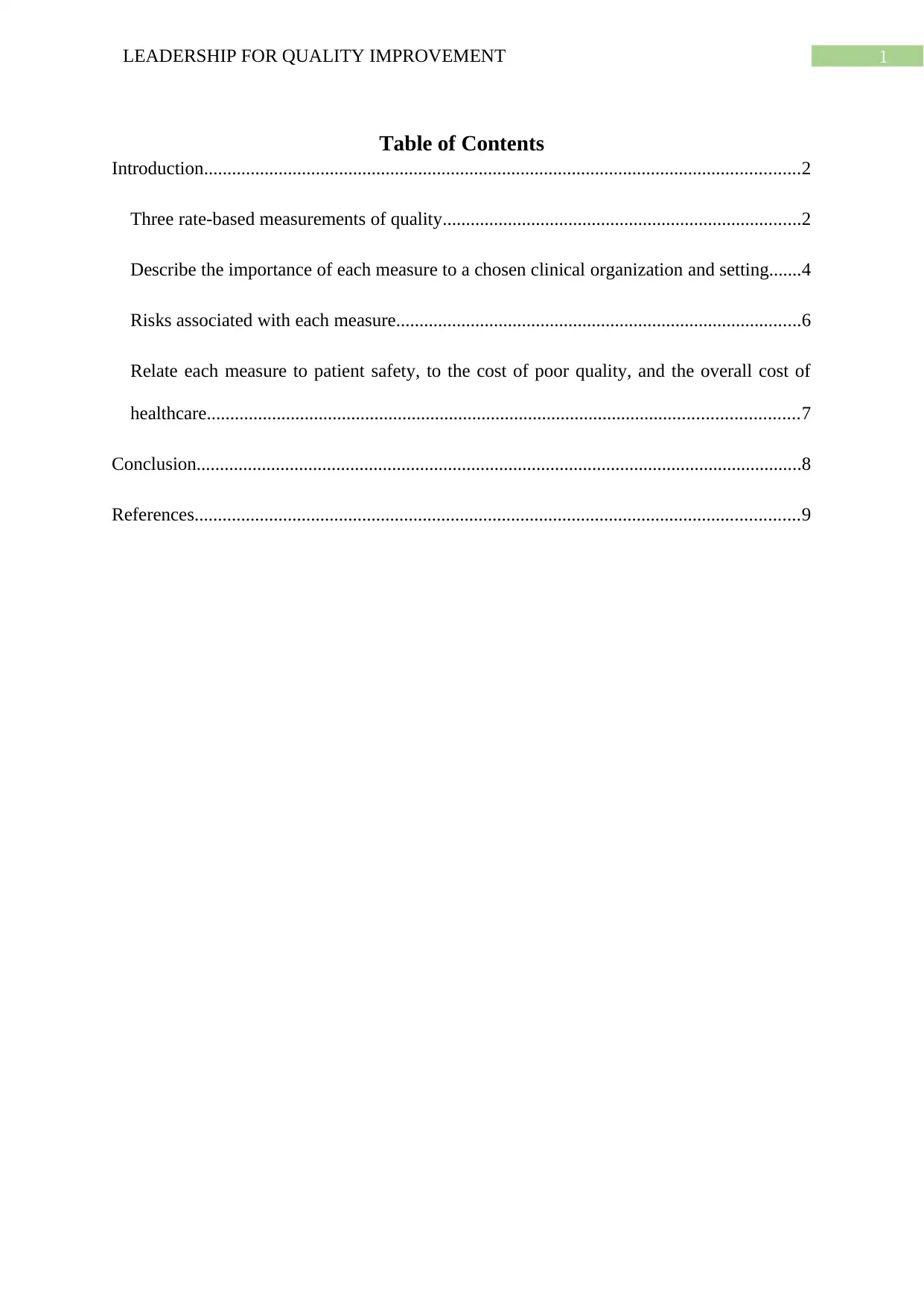
1LEADERSHIP FOR QUALITY IMPROVEMENT
Table of Contents
Introduction................................................................................................................................2
Three rate-based measurements of quality.............................................................................2
Describe the importance of each measure to a chosen clinical organization and setting.......4
Risks associated with each measure.......................................................................................6
Relate each measure to patient safety, to the cost of poor quality, and the overall cost of
healthcare...............................................................................................................................7
Conclusion..................................................................................................................................8
References..................................................................................................................................9
Table of Contents
Introduction................................................................................................................................2
Three rate-based measurements of quality.............................................................................2
Describe the importance of each measure to a chosen clinical organization and setting.......4
Risks associated with each measure.......................................................................................6
Relate each measure to patient safety, to the cost of poor quality, and the overall cost of
healthcare...............................................................................................................................7
Conclusion..................................................................................................................................8
References..................................................................................................................................9
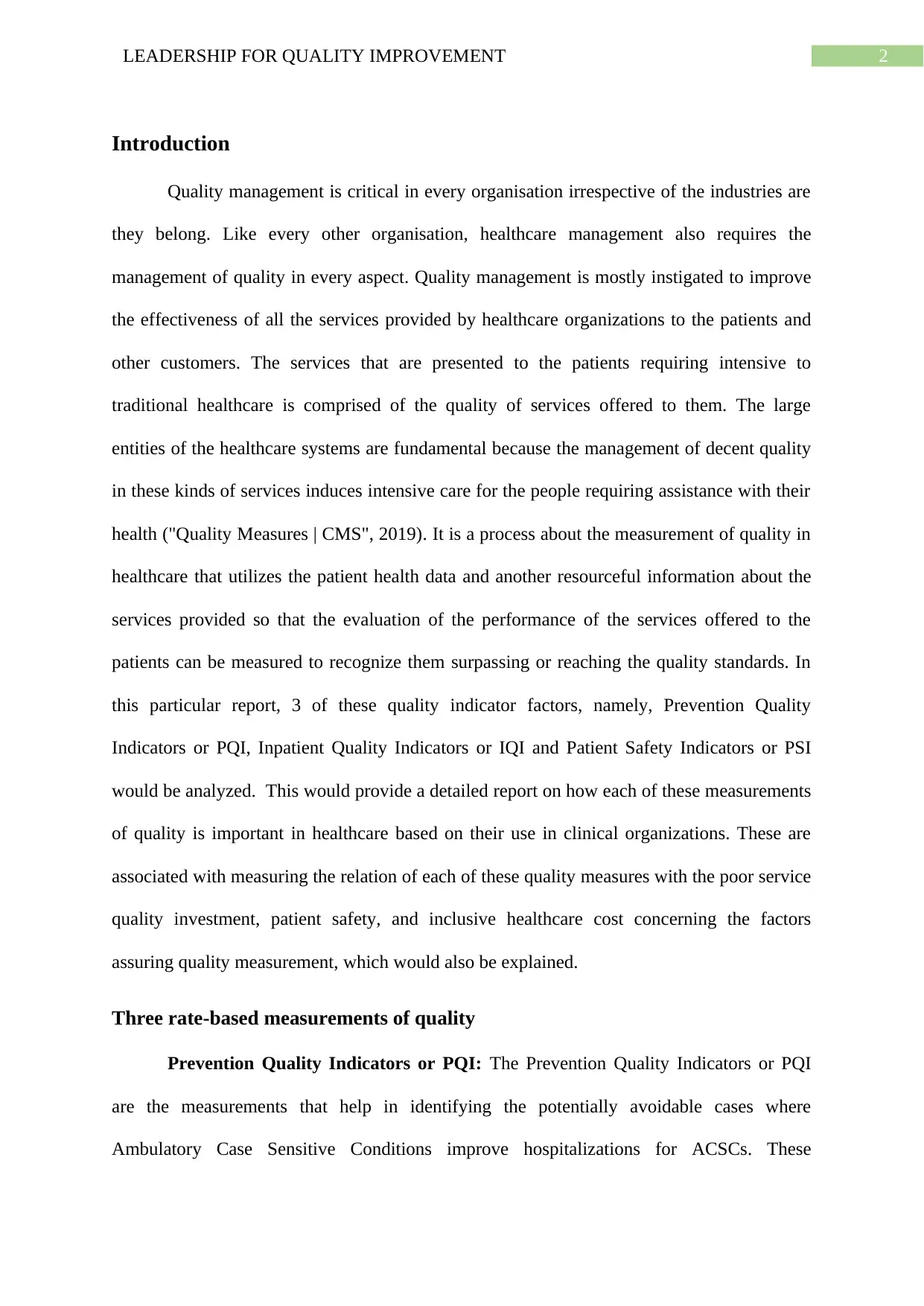
2LEADERSHIP FOR QUALITY IMPROVEMENT
Introduction
Quality management is critical in every organisation irrespective of the industries are
they belong. Like every other organisation, healthcare management also requires the
management of quality in every aspect. Quality management is mostly instigated to improve
the effectiveness of all the services provided by healthcare organizations to the patients and
other customers. The services that are presented to the patients requiring intensive to
traditional healthcare is comprised of the quality of services offered to them. The large
entities of the healthcare systems are fundamental because the management of decent quality
in these kinds of services induces intensive care for the people requiring assistance with their
health ("Quality Measures | CMS", 2019). It is a process about the measurement of quality in
healthcare that utilizes the patient health data and another resourceful information about the
services provided so that the evaluation of the performance of the services offered to the
patients can be measured to recognize them surpassing or reaching the quality standards. In
this particular report, 3 of these quality indicator factors, namely, Prevention Quality
Indicators or PQI, Inpatient Quality Indicators or IQI and Patient Safety Indicators or PSI
would be analyzed. This would provide a detailed report on how each of these measurements
of quality is important in healthcare based on their use in clinical organizations. These are
associated with measuring the relation of each of these quality measures with the poor service
quality investment, patient safety, and inclusive healthcare cost concerning the factors
assuring quality measurement, which would also be explained.
Three rate-based measurements of quality
Prevention Quality Indicators or PQI: The Prevention Quality Indicators or PQI
are the measurements that help in identifying the potentially avoidable cases where
Ambulatory Case Sensitive Conditions improve hospitalizations for ACSCs. These
Introduction
Quality management is critical in every organisation irrespective of the industries are
they belong. Like every other organisation, healthcare management also requires the
management of quality in every aspect. Quality management is mostly instigated to improve
the effectiveness of all the services provided by healthcare organizations to the patients and
other customers. The services that are presented to the patients requiring intensive to
traditional healthcare is comprised of the quality of services offered to them. The large
entities of the healthcare systems are fundamental because the management of decent quality
in these kinds of services induces intensive care for the people requiring assistance with their
health ("Quality Measures | CMS", 2019). It is a process about the measurement of quality in
healthcare that utilizes the patient health data and another resourceful information about the
services provided so that the evaluation of the performance of the services offered to the
patients can be measured to recognize them surpassing or reaching the quality standards. In
this particular report, 3 of these quality indicator factors, namely, Prevention Quality
Indicators or PQI, Inpatient Quality Indicators or IQI and Patient Safety Indicators or PSI
would be analyzed. This would provide a detailed report on how each of these measurements
of quality is important in healthcare based on their use in clinical organizations. These are
associated with measuring the relation of each of these quality measures with the poor service
quality investment, patient safety, and inclusive healthcare cost concerning the factors
assuring quality measurement, which would also be explained.
Three rate-based measurements of quality
Prevention Quality Indicators or PQI: The Prevention Quality Indicators or PQI
are the measurements that help in identifying the potentially avoidable cases where
Ambulatory Case Sensitive Conditions improve hospitalizations for ACSCs. These
⊘ This is a preview!⊘
Do you want full access?
Subscribe today to unlock all pages.

Trusted by 1+ million students worldwide
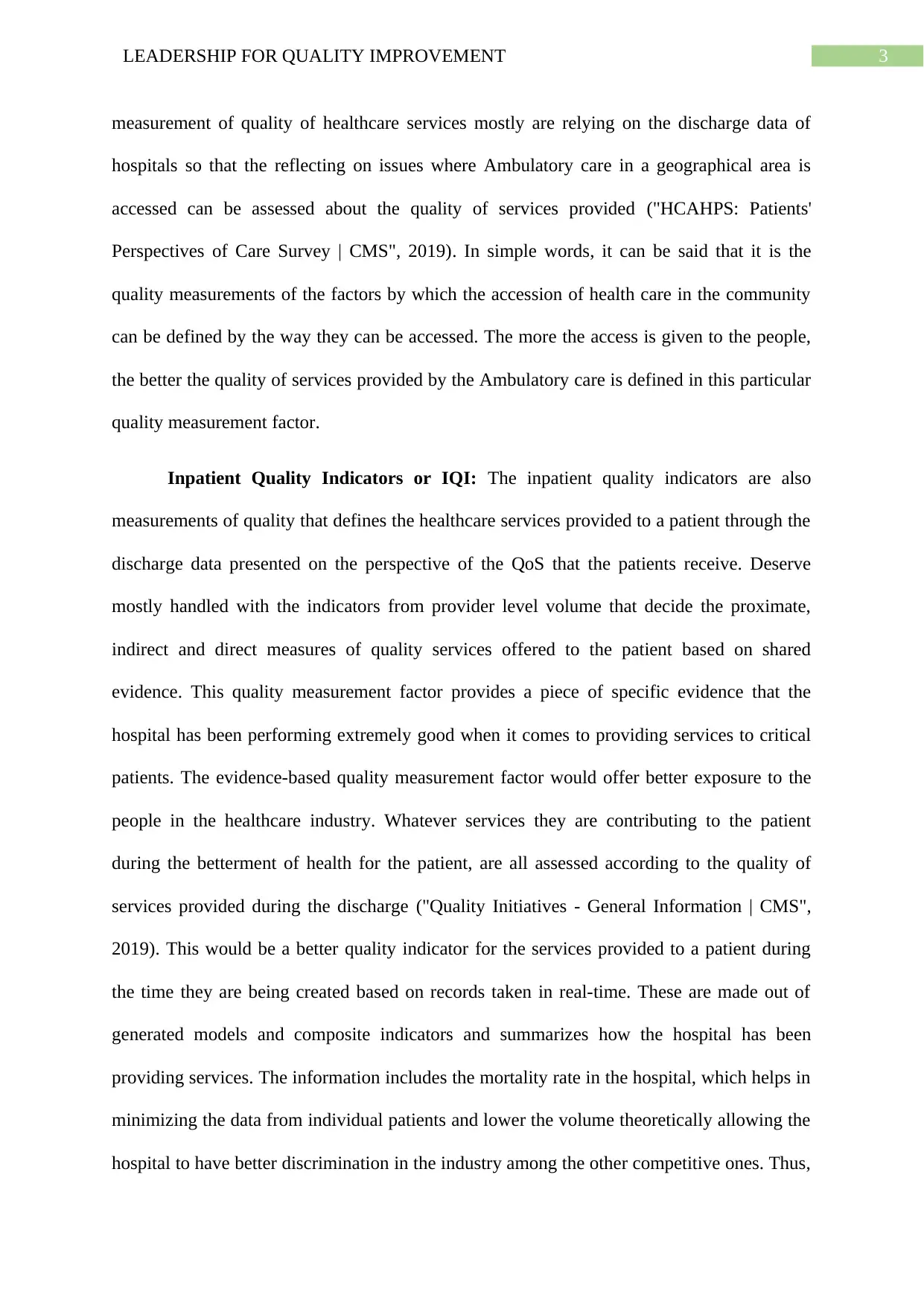
3LEADERSHIP FOR QUALITY IMPROVEMENT
measurement of quality of healthcare services mostly are relying on the discharge data of
hospitals so that the reflecting on issues where Ambulatory care in a geographical area is
accessed can be assessed about the quality of services provided ("HCAHPS: Patients'
Perspectives of Care Survey | CMS", 2019). In simple words, it can be said that it is the
quality measurements of the factors by which the accession of health care in the community
can be defined by the way they can be accessed. The more the access is given to the people,
the better the quality of services provided by the Ambulatory care is defined in this particular
quality measurement factor.
Inpatient Quality Indicators or IQI: The inpatient quality indicators are also
measurements of quality that defines the healthcare services provided to a patient through the
discharge data presented on the perspective of the QoS that the patients receive. Deserve
mostly handled with the indicators from provider level volume that decide the proximate,
indirect and direct measures of quality services offered to the patient based on shared
evidence. This quality measurement factor provides a piece of specific evidence that the
hospital has been performing extremely good when it comes to providing services to critical
patients. The evidence-based quality measurement factor would offer better exposure to the
people in the healthcare industry. Whatever services they are contributing to the patient
during the betterment of health for the patient, are all assessed according to the quality of
services provided during the discharge ("Quality Initiatives - General Information | CMS",
2019). This would be a better quality indicator for the services provided to a patient during
the time they are being created based on records taken in real-time. These are made out of
generated models and composite indicators and summarizes how the hospital has been
providing services. The information includes the mortality rate in the hospital, which helps in
minimizing the data from individual patients and lower the volume theoretically allowing the
hospital to have better discrimination in the industry among the other competitive ones. Thus,
measurement of quality of healthcare services mostly are relying on the discharge data of
hospitals so that the reflecting on issues where Ambulatory care in a geographical area is
accessed can be assessed about the quality of services provided ("HCAHPS: Patients'
Perspectives of Care Survey | CMS", 2019). In simple words, it can be said that it is the
quality measurements of the factors by which the accession of health care in the community
can be defined by the way they can be accessed. The more the access is given to the people,
the better the quality of services provided by the Ambulatory care is defined in this particular
quality measurement factor.
Inpatient Quality Indicators or IQI: The inpatient quality indicators are also
measurements of quality that defines the healthcare services provided to a patient through the
discharge data presented on the perspective of the QoS that the patients receive. Deserve
mostly handled with the indicators from provider level volume that decide the proximate,
indirect and direct measures of quality services offered to the patient based on shared
evidence. This quality measurement factor provides a piece of specific evidence that the
hospital has been performing extremely good when it comes to providing services to critical
patients. The evidence-based quality measurement factor would offer better exposure to the
people in the healthcare industry. Whatever services they are contributing to the patient
during the betterment of health for the patient, are all assessed according to the quality of
services provided during the discharge ("Quality Initiatives - General Information | CMS",
2019). This would be a better quality indicator for the services provided to a patient during
the time they are being created based on records taken in real-time. These are made out of
generated models and composite indicators and summarizes how the hospital has been
providing services. The information includes the mortality rate in the hospital, which helps in
minimizing the data from individual patients and lower the volume theoretically allowing the
hospital to have better discrimination in the industry among the other competitive ones. Thus,
Paraphrase This Document
Need a fresh take? Get an instant paraphrase of this document with our AI Paraphraser
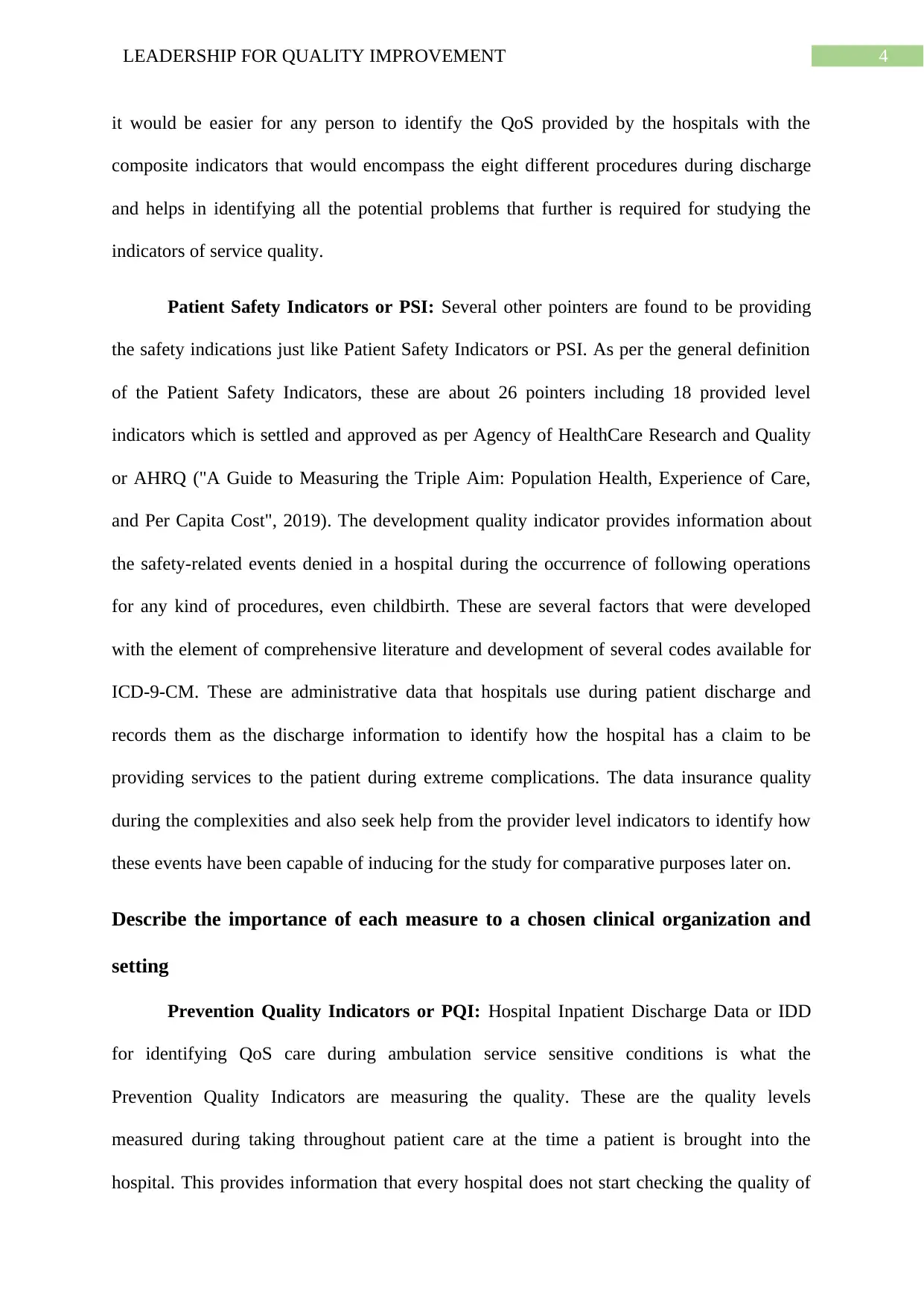
4LEADERSHIP FOR QUALITY IMPROVEMENT
it would be easier for any person to identify the QoS provided by the hospitals with the
composite indicators that would encompass the eight different procedures during discharge
and helps in identifying all the potential problems that further is required for studying the
indicators of service quality.
Patient Safety Indicators or PSI: Several other pointers are found to be providing
the safety indications just like Patient Safety Indicators or PSI. As per the general definition
of the Patient Safety Indicators, these are about 26 pointers including 18 provided level
indicators which is settled and approved as per Agency of HealthCare Research and Quality
or AHRQ ("A Guide to Measuring the Triple Aim: Population Health, Experience of Care,
and Per Capita Cost", 2019). The development quality indicator provides information about
the safety-related events denied in a hospital during the occurrence of following operations
for any kind of procedures, even childbirth. These are several factors that were developed
with the element of comprehensive literature and development of several codes available for
ICD-9-CM. These are administrative data that hospitals use during patient discharge and
records them as the discharge information to identify how the hospital has a claim to be
providing services to the patient during extreme complications. The data insurance quality
during the complexities and also seek help from the provider level indicators to identify how
these events have been capable of inducing for the study for comparative purposes later on.
Describe the importance of each measure to a chosen clinical organization and
setting
Prevention Quality Indicators or PQI: Hospital Inpatient Discharge Data or IDD
for identifying QoS care during ambulation service sensitive conditions is what the
Prevention Quality Indicators are measuring the quality. These are the quality levels
measured during taking throughout patient care at the time a patient is brought into the
hospital. This provides information that every hospital does not start checking the quality of
it would be easier for any person to identify the QoS provided by the hospitals with the
composite indicators that would encompass the eight different procedures during discharge
and helps in identifying all the potential problems that further is required for studying the
indicators of service quality.
Patient Safety Indicators or PSI: Several other pointers are found to be providing
the safety indications just like Patient Safety Indicators or PSI. As per the general definition
of the Patient Safety Indicators, these are about 26 pointers including 18 provided level
indicators which is settled and approved as per Agency of HealthCare Research and Quality
or AHRQ ("A Guide to Measuring the Triple Aim: Population Health, Experience of Care,
and Per Capita Cost", 2019). The development quality indicator provides information about
the safety-related events denied in a hospital during the occurrence of following operations
for any kind of procedures, even childbirth. These are several factors that were developed
with the element of comprehensive literature and development of several codes available for
ICD-9-CM. These are administrative data that hospitals use during patient discharge and
records them as the discharge information to identify how the hospital has a claim to be
providing services to the patient during extreme complications. The data insurance quality
during the complexities and also seek help from the provider level indicators to identify how
these events have been capable of inducing for the study for comparative purposes later on.
Describe the importance of each measure to a chosen clinical organization and
setting
Prevention Quality Indicators or PQI: Hospital Inpatient Discharge Data or IDD
for identifying QoS care during ambulation service sensitive conditions is what the
Prevention Quality Indicators are measuring the quality. These are the quality levels
measured during taking throughout patient care at the time a patient is brought into the
hospital. This provides information that every hospital does not start checking the quality of
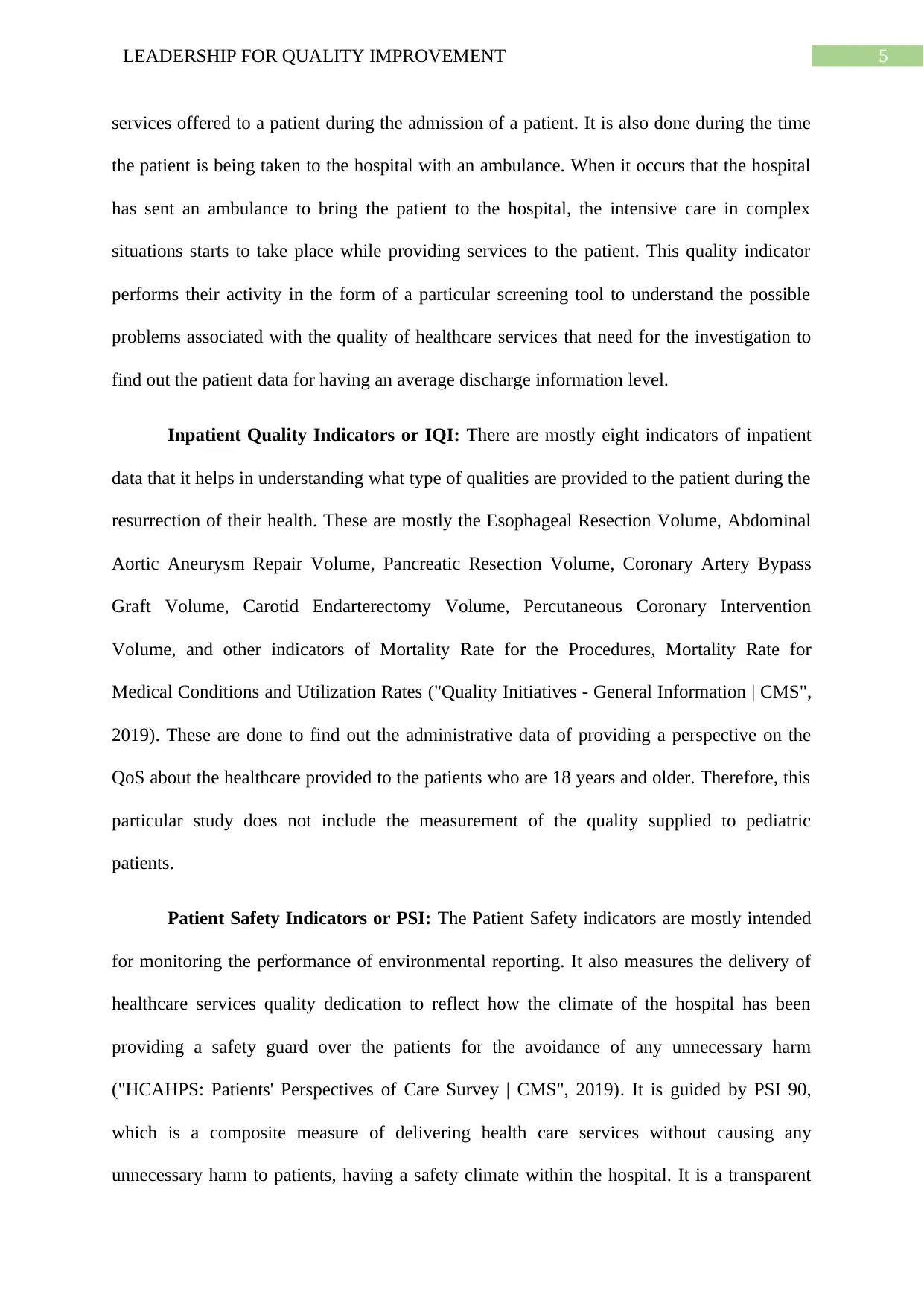
5LEADERSHIP FOR QUALITY IMPROVEMENT
services offered to a patient during the admission of a patient. It is also done during the time
the patient is being taken to the hospital with an ambulance. When it occurs that the hospital
has sent an ambulance to bring the patient to the hospital, the intensive care in complex
situations starts to take place while providing services to the patient. This quality indicator
performs their activity in the form of a particular screening tool to understand the possible
problems associated with the quality of healthcare services that need for the investigation to
find out the patient data for having an average discharge information level.
Inpatient Quality Indicators or IQI: There are mostly eight indicators of inpatient
data that it helps in understanding what type of qualities are provided to the patient during the
resurrection of their health. These are mostly the Esophageal Resection Volume, Abdominal
Aortic Aneurysm Repair Volume, Pancreatic Resection Volume, Coronary Artery Bypass
Graft Volume, Carotid Endarterectomy Volume, Percutaneous Coronary Intervention
Volume, and other indicators of Mortality Rate for the Procedures, Mortality Rate for
Medical Conditions and Utilization Rates ("Quality Initiatives - General Information | CMS",
2019). These are done to find out the administrative data of providing a perspective on the
QoS about the healthcare provided to the patients who are 18 years and older. Therefore, this
particular study does not include the measurement of the quality supplied to pediatric
patients.
Patient Safety Indicators or PSI: The Patient Safety indicators are mostly intended
for monitoring the performance of environmental reporting. It also measures the delivery of
healthcare services quality dedication to reflect how the climate of the hospital has been
providing a safety guard over the patients for the avoidance of any unnecessary harm
("HCAHPS: Patients' Perspectives of Care Survey | CMS", 2019). It is guided by PSI 90,
which is a composite measure of delivering health care services without causing any
unnecessary harm to patients, having a safety climate within the hospital. It is a transparent
services offered to a patient during the admission of a patient. It is also done during the time
the patient is being taken to the hospital with an ambulance. When it occurs that the hospital
has sent an ambulance to bring the patient to the hospital, the intensive care in complex
situations starts to take place while providing services to the patient. This quality indicator
performs their activity in the form of a particular screening tool to understand the possible
problems associated with the quality of healthcare services that need for the investigation to
find out the patient data for having an average discharge information level.
Inpatient Quality Indicators or IQI: There are mostly eight indicators of inpatient
data that it helps in understanding what type of qualities are provided to the patient during the
resurrection of their health. These are mostly the Esophageal Resection Volume, Abdominal
Aortic Aneurysm Repair Volume, Pancreatic Resection Volume, Coronary Artery Bypass
Graft Volume, Carotid Endarterectomy Volume, Percutaneous Coronary Intervention
Volume, and other indicators of Mortality Rate for the Procedures, Mortality Rate for
Medical Conditions and Utilization Rates ("Quality Initiatives - General Information | CMS",
2019). These are done to find out the administrative data of providing a perspective on the
QoS about the healthcare provided to the patients who are 18 years and older. Therefore, this
particular study does not include the measurement of the quality supplied to pediatric
patients.
Patient Safety Indicators or PSI: The Patient Safety indicators are mostly intended
for monitoring the performance of environmental reporting. It also measures the delivery of
healthcare services quality dedication to reflect how the climate of the hospital has been
providing a safety guard over the patients for the avoidance of any unnecessary harm
("HCAHPS: Patients' Perspectives of Care Survey | CMS", 2019). It is guided by PSI 90,
which is a composite measure of delivering health care services without causing any
unnecessary harm to patients, having a safety climate within the hospital. It is a transparent
⊘ This is a preview!⊘
Do you want full access?
Subscribe today to unlock all pages.

Trusted by 1+ million students worldwide
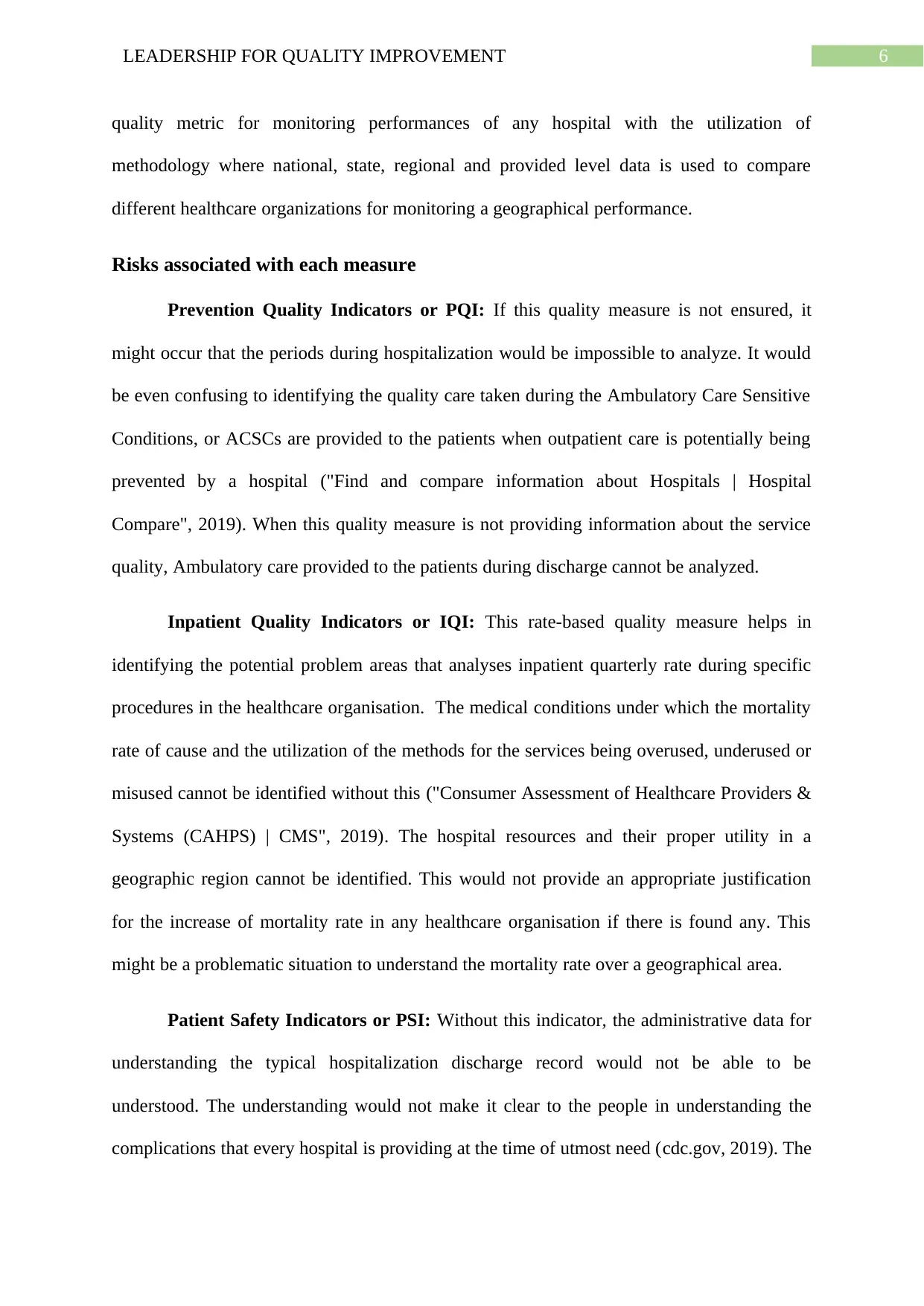
6LEADERSHIP FOR QUALITY IMPROVEMENT
quality metric for monitoring performances of any hospital with the utilization of
methodology where national, state, regional and provided level data is used to compare
different healthcare organizations for monitoring a geographical performance.
Risks associated with each measure
Prevention Quality Indicators or PQI: If this quality measure is not ensured, it
might occur that the periods during hospitalization would be impossible to analyze. It would
be even confusing to identifying the quality care taken during the Ambulatory Care Sensitive
Conditions, or ACSCs are provided to the patients when outpatient care is potentially being
prevented by a hospital ("Find and compare information about Hospitals | Hospital
Compare", 2019). When this quality measure is not providing information about the service
quality, Ambulatory care provided to the patients during discharge cannot be analyzed.
Inpatient Quality Indicators or IQI: This rate-based quality measure helps in
identifying the potential problem areas that analyses inpatient quarterly rate during specific
procedures in the healthcare organisation. The medical conditions under which the mortality
rate of cause and the utilization of the methods for the services being overused, underused or
misused cannot be identified without this ("Consumer Assessment of Healthcare Providers &
Systems (CAHPS) | CMS", 2019). The hospital resources and their proper utility in a
geographic region cannot be identified. This would not provide an appropriate justification
for the increase of mortality rate in any healthcare organisation if there is found any. This
might be a problematic situation to understand the mortality rate over a geographical area.
Patient Safety Indicators or PSI: Without this indicator, the administrative data for
understanding the typical hospitalization discharge record would not be able to be
understood. The understanding would not make it clear to the people in understanding the
complications that every hospital is providing at the time of utmost need (cdc.gov, 2019). The
quality metric for monitoring performances of any hospital with the utilization of
methodology where national, state, regional and provided level data is used to compare
different healthcare organizations for monitoring a geographical performance.
Risks associated with each measure
Prevention Quality Indicators or PQI: If this quality measure is not ensured, it
might occur that the periods during hospitalization would be impossible to analyze. It would
be even confusing to identifying the quality care taken during the Ambulatory Care Sensitive
Conditions, or ACSCs are provided to the patients when outpatient care is potentially being
prevented by a hospital ("Find and compare information about Hospitals | Hospital
Compare", 2019). When this quality measure is not providing information about the service
quality, Ambulatory care provided to the patients during discharge cannot be analyzed.
Inpatient Quality Indicators or IQI: This rate-based quality measure helps in
identifying the potential problem areas that analyses inpatient quarterly rate during specific
procedures in the healthcare organisation. The medical conditions under which the mortality
rate of cause and the utilization of the methods for the services being overused, underused or
misused cannot be identified without this ("Consumer Assessment of Healthcare Providers &
Systems (CAHPS) | CMS", 2019). The hospital resources and their proper utility in a
geographic region cannot be identified. This would not provide an appropriate justification
for the increase of mortality rate in any healthcare organisation if there is found any. This
might be a problematic situation to understand the mortality rate over a geographical area.
Patient Safety Indicators or PSI: Without this indicator, the administrative data for
understanding the typical hospitalization discharge record would not be able to be
understood. The understanding would not make it clear to the people in understanding the
complications that every hospital is providing at the time of utmost need (cdc.gov, 2019). The
Paraphrase This Document
Need a fresh take? Get an instant paraphrase of this document with our AI Paraphraser
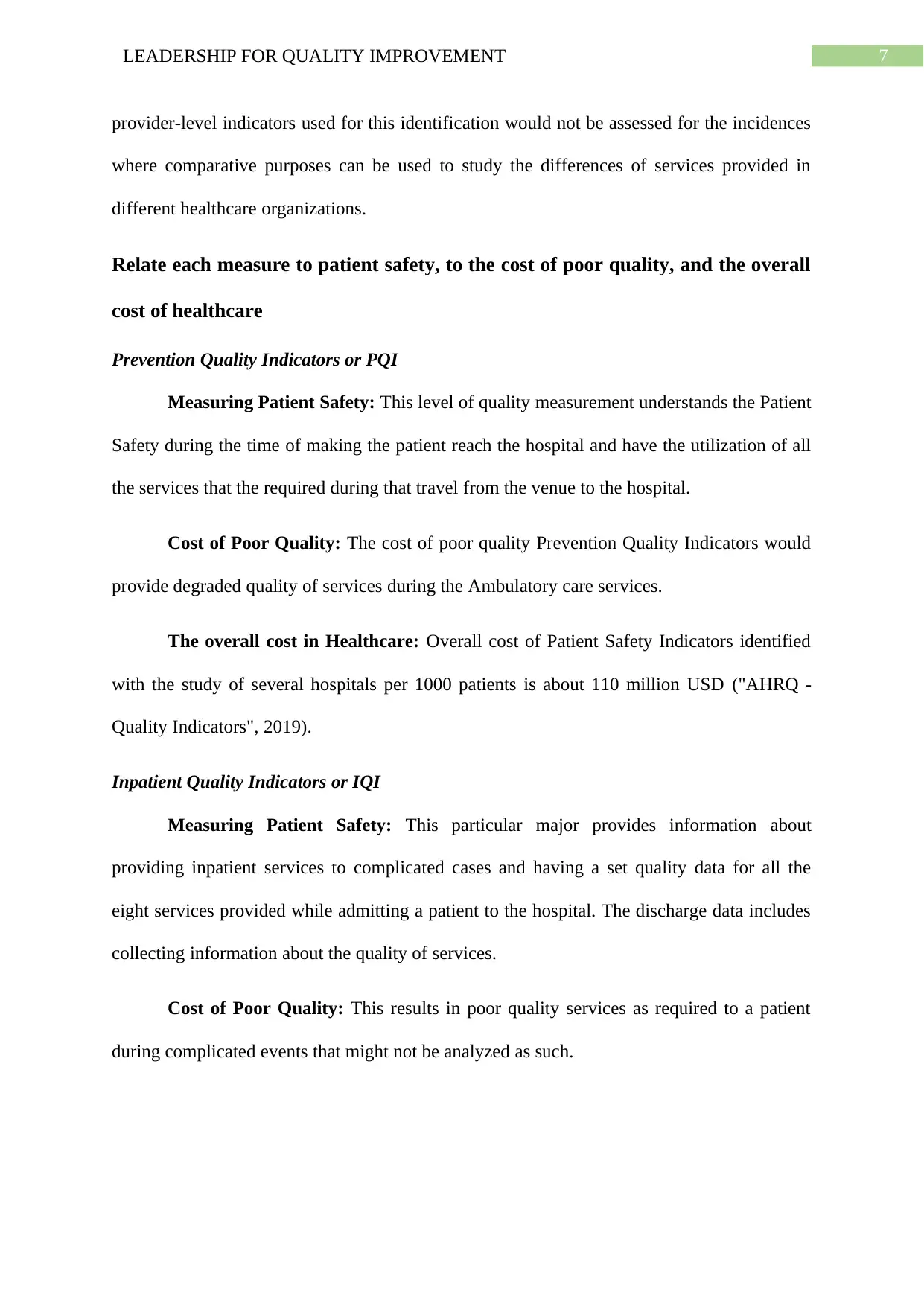
7LEADERSHIP FOR QUALITY IMPROVEMENT
provider-level indicators used for this identification would not be assessed for the incidences
where comparative purposes can be used to study the differences of services provided in
different healthcare organizations.
Relate each measure to patient safety, to the cost of poor quality, and the overall
cost of healthcare
Prevention Quality Indicators or PQI
Measuring Patient Safety: This level of quality measurement understands the Patient
Safety during the time of making the patient reach the hospital and have the utilization of all
the services that the required during that travel from the venue to the hospital.
Cost of Poor Quality: The cost of poor quality Prevention Quality Indicators would
provide degraded quality of services during the Ambulatory care services.
The overall cost in Healthcare: Overall cost of Patient Safety Indicators identified
with the study of several hospitals per 1000 patients is about 110 million USD ("AHRQ -
Quality Indicators", 2019).
Inpatient Quality Indicators or IQI
Measuring Patient Safety: This particular major provides information about
providing inpatient services to complicated cases and having a set quality data for all the
eight services provided while admitting a patient to the hospital. The discharge data includes
collecting information about the quality of services.
Cost of Poor Quality: This results in poor quality services as required to a patient
during complicated events that might not be analyzed as such.
provider-level indicators used for this identification would not be assessed for the incidences
where comparative purposes can be used to study the differences of services provided in
different healthcare organizations.
Relate each measure to patient safety, to the cost of poor quality, and the overall
cost of healthcare
Prevention Quality Indicators or PQI
Measuring Patient Safety: This level of quality measurement understands the Patient
Safety during the time of making the patient reach the hospital and have the utilization of all
the services that the required during that travel from the venue to the hospital.
Cost of Poor Quality: The cost of poor quality Prevention Quality Indicators would
provide degraded quality of services during the Ambulatory care services.
The overall cost in Healthcare: Overall cost of Patient Safety Indicators identified
with the study of several hospitals per 1000 patients is about 110 million USD ("AHRQ -
Quality Indicators", 2019).
Inpatient Quality Indicators or IQI
Measuring Patient Safety: This particular major provides information about
providing inpatient services to complicated cases and having a set quality data for all the
eight services provided while admitting a patient to the hospital. The discharge data includes
collecting information about the quality of services.
Cost of Poor Quality: This results in poor quality services as required to a patient
during complicated events that might not be analyzed as such.
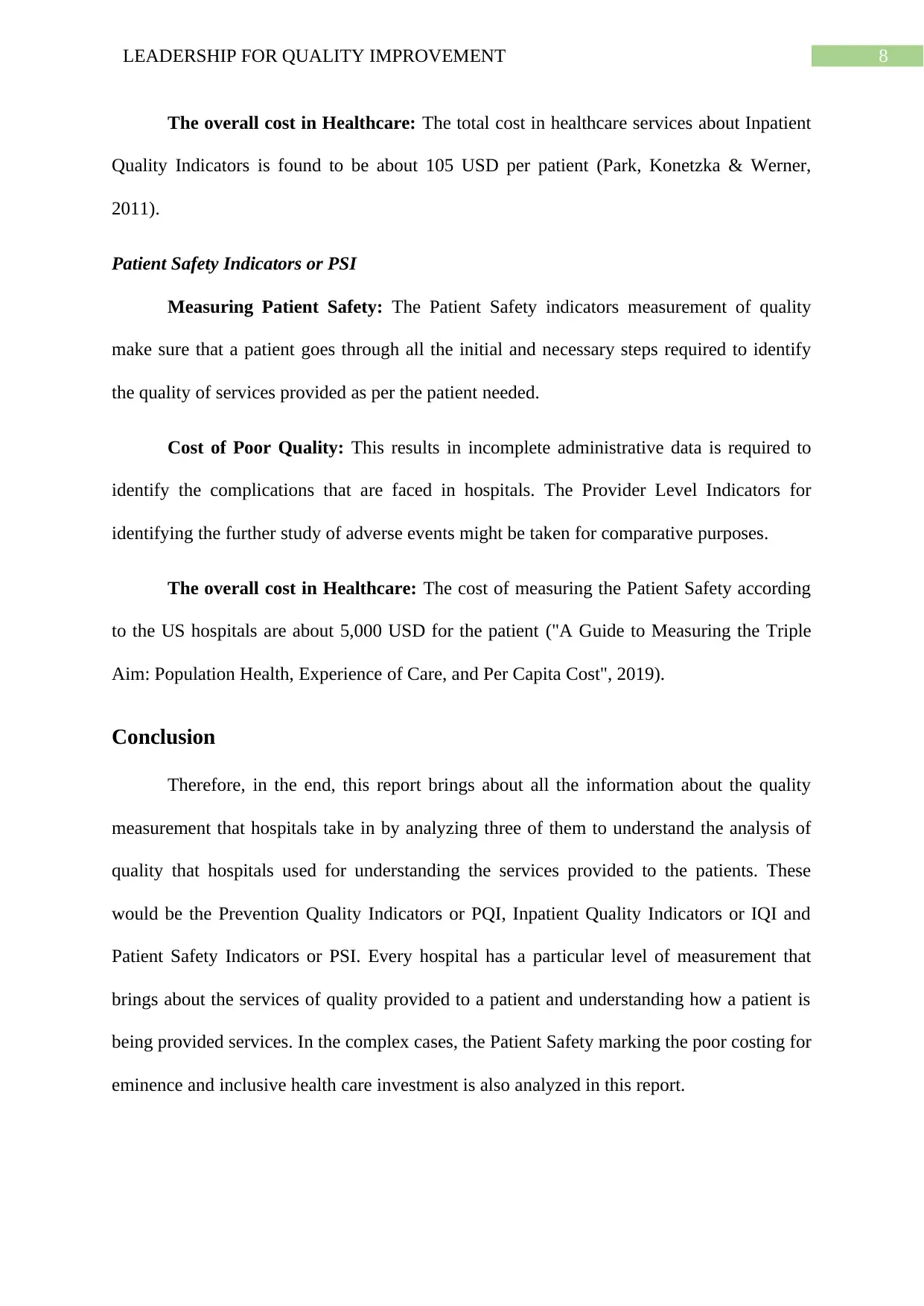
8LEADERSHIP FOR QUALITY IMPROVEMENT
The overall cost in Healthcare: The total cost in healthcare services about Inpatient
Quality Indicators is found to be about 105 USD per patient (Park, Konetzka & Werner,
2011).
Patient Safety Indicators or PSI
Measuring Patient Safety: The Patient Safety indicators measurement of quality
make sure that a patient goes through all the initial and necessary steps required to identify
the quality of services provided as per the patient needed.
Cost of Poor Quality: This results in incomplete administrative data is required to
identify the complications that are faced in hospitals. The Provider Level Indicators for
identifying the further study of adverse events might be taken for comparative purposes.
The overall cost in Healthcare: The cost of measuring the Patient Safety according
to the US hospitals are about 5,000 USD for the patient ("A Guide to Measuring the Triple
Aim: Population Health, Experience of Care, and Per Capita Cost", 2019).
Conclusion
Therefore, in the end, this report brings about all the information about the quality
measurement that hospitals take in by analyzing three of them to understand the analysis of
quality that hospitals used for understanding the services provided to the patients. These
would be the Prevention Quality Indicators or PQI, Inpatient Quality Indicators or IQI and
Patient Safety Indicators or PSI. Every hospital has a particular level of measurement that
brings about the services of quality provided to a patient and understanding how a patient is
being provided services. In the complex cases, the Patient Safety marking the poor costing for
eminence and inclusive health care investment is also analyzed in this report.
The overall cost in Healthcare: The total cost in healthcare services about Inpatient
Quality Indicators is found to be about 105 USD per patient (Park, Konetzka & Werner,
2011).
Patient Safety Indicators or PSI
Measuring Patient Safety: The Patient Safety indicators measurement of quality
make sure that a patient goes through all the initial and necessary steps required to identify
the quality of services provided as per the patient needed.
Cost of Poor Quality: This results in incomplete administrative data is required to
identify the complications that are faced in hospitals. The Provider Level Indicators for
identifying the further study of adverse events might be taken for comparative purposes.
The overall cost in Healthcare: The cost of measuring the Patient Safety according
to the US hospitals are about 5,000 USD for the patient ("A Guide to Measuring the Triple
Aim: Population Health, Experience of Care, and Per Capita Cost", 2019).
Conclusion
Therefore, in the end, this report brings about all the information about the quality
measurement that hospitals take in by analyzing three of them to understand the analysis of
quality that hospitals used for understanding the services provided to the patients. These
would be the Prevention Quality Indicators or PQI, Inpatient Quality Indicators or IQI and
Patient Safety Indicators or PSI. Every hospital has a particular level of measurement that
brings about the services of quality provided to a patient and understanding how a patient is
being provided services. In the complex cases, the Patient Safety marking the poor costing for
eminence and inclusive health care investment is also analyzed in this report.
⊘ This is a preview!⊘
Do you want full access?
Subscribe today to unlock all pages.

Trusted by 1+ million students worldwide
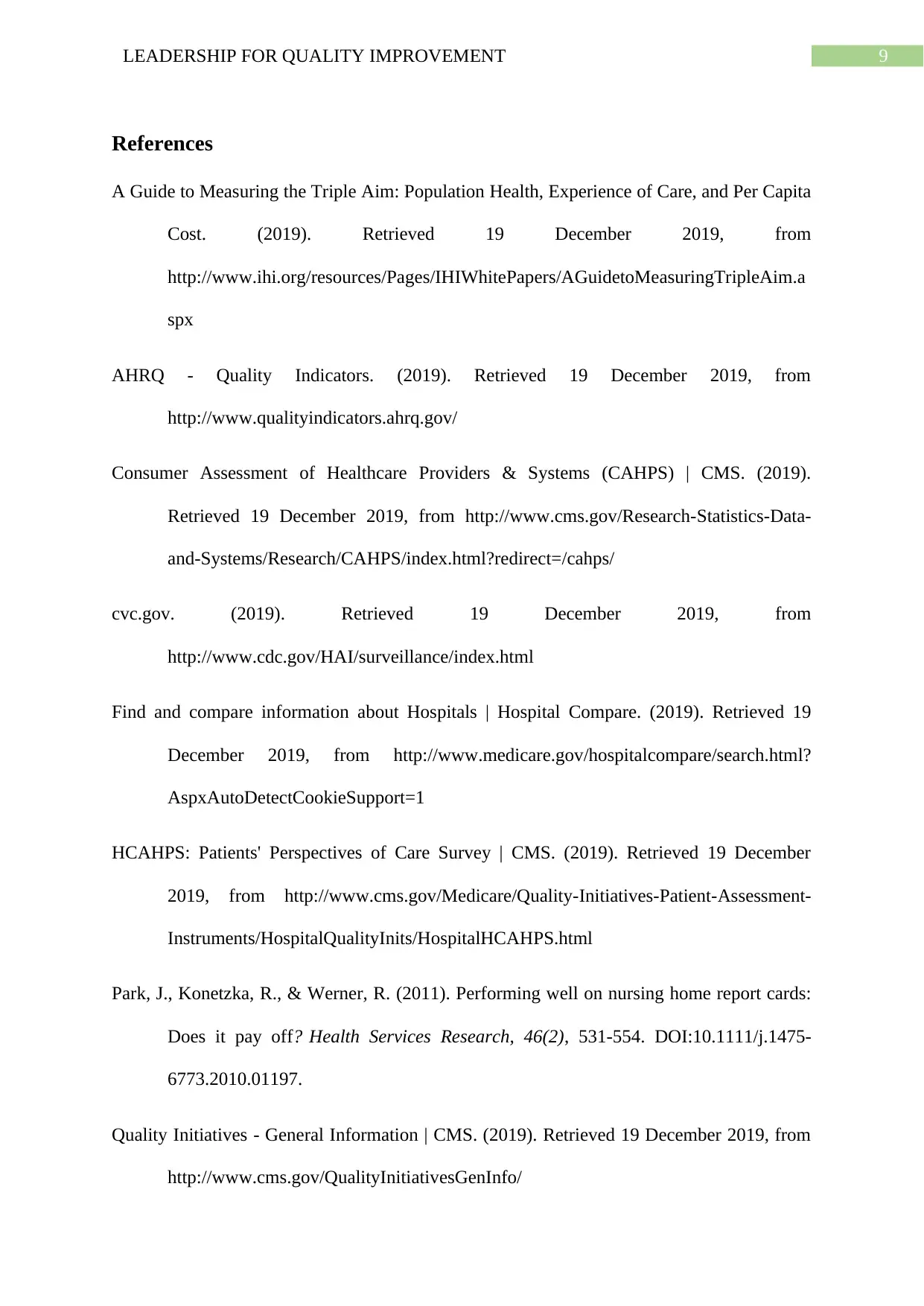
9LEADERSHIP FOR QUALITY IMPROVEMENT
References
A Guide to Measuring the Triple Aim: Population Health, Experience of Care, and Per Capita
Cost. (2019). Retrieved 19 December 2019, from
http://www.ihi.org/resources/Pages/IHIWhitePapers/AGuidetoMeasuringTripleAim.a
spx
AHRQ - Quality Indicators. (2019). Retrieved 19 December 2019, from
http://www.qualityindicators.ahrq.gov/
Consumer Assessment of Healthcare Providers & Systems (CAHPS) | CMS. (2019).
Retrieved 19 December 2019, from http://www.cms.gov/Research-Statistics-Data-
and-Systems/Research/CAHPS/index.html?redirect=/cahps/
cvc.gov. (2019). Retrieved 19 December 2019, from
http://www.cdc.gov/HAI/surveillance/index.html
Find and compare information about Hospitals | Hospital Compare. (2019). Retrieved 19
December 2019, from http://www.medicare.gov/hospitalcompare/search.html?
AspxAutoDetectCookieSupport=1
HCAHPS: Patients' Perspectives of Care Survey | CMS. (2019). Retrieved 19 December
2019, from http://www.cms.gov/Medicare/Quality-Initiatives-Patient-Assessment-
Instruments/HospitalQualityInits/HospitalHCAHPS.html
Park, J., Konetzka, R., & Werner, R. (2011). Performing well on nursing home report cards:
Does it pay off? Health Services Research, 46(2), 531-554. DOI:10.1111/j.1475-
6773.2010.01197.
Quality Initiatives - General Information | CMS. (2019). Retrieved 19 December 2019, from
http://www.cms.gov/QualityInitiativesGenInfo/
References
A Guide to Measuring the Triple Aim: Population Health, Experience of Care, and Per Capita
Cost. (2019). Retrieved 19 December 2019, from
http://www.ihi.org/resources/Pages/IHIWhitePapers/AGuidetoMeasuringTripleAim.a
spx
AHRQ - Quality Indicators. (2019). Retrieved 19 December 2019, from
http://www.qualityindicators.ahrq.gov/
Consumer Assessment of Healthcare Providers & Systems (CAHPS) | CMS. (2019).
Retrieved 19 December 2019, from http://www.cms.gov/Research-Statistics-Data-
and-Systems/Research/CAHPS/index.html?redirect=/cahps/
cvc.gov. (2019). Retrieved 19 December 2019, from
http://www.cdc.gov/HAI/surveillance/index.html
Find and compare information about Hospitals | Hospital Compare. (2019). Retrieved 19
December 2019, from http://www.medicare.gov/hospitalcompare/search.html?
AspxAutoDetectCookieSupport=1
HCAHPS: Patients' Perspectives of Care Survey | CMS. (2019). Retrieved 19 December
2019, from http://www.cms.gov/Medicare/Quality-Initiatives-Patient-Assessment-
Instruments/HospitalQualityInits/HospitalHCAHPS.html
Park, J., Konetzka, R., & Werner, R. (2011). Performing well on nursing home report cards:
Does it pay off? Health Services Research, 46(2), 531-554. DOI:10.1111/j.1475-
6773.2010.01197.
Quality Initiatives - General Information | CMS. (2019). Retrieved 19 December 2019, from
http://www.cms.gov/QualityInitiativesGenInfo/
Paraphrase This Document
Need a fresh take? Get an instant paraphrase of this document with our AI Paraphraser
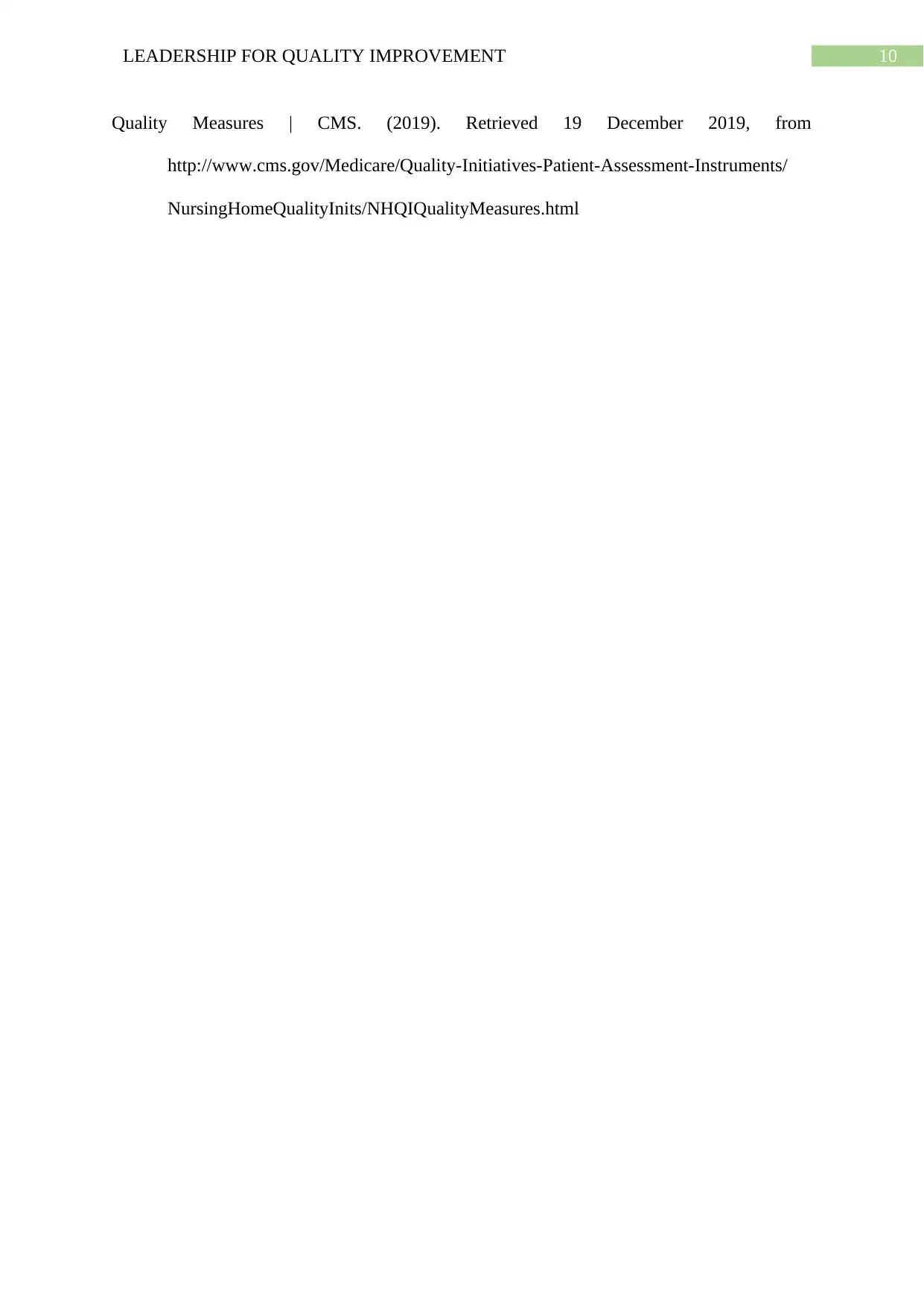
10LEADERSHIP FOR QUALITY IMPROVEMENT
Quality Measures | CMS. (2019). Retrieved 19 December 2019, from
http://www.cms.gov/Medicare/Quality-Initiatives-Patient-Assessment-Instruments/
NursingHomeQualityInits/NHQIQualityMeasures.html
Quality Measures | CMS. (2019). Retrieved 19 December 2019, from
http://www.cms.gov/Medicare/Quality-Initiatives-Patient-Assessment-Instruments/
NursingHomeQualityInits/NHQIQualityMeasures.html
1 out of 11
Related Documents
Your All-in-One AI-Powered Toolkit for Academic Success.
+13062052269
info@desklib.com
Available 24*7 on WhatsApp / Email
![[object Object]](/_next/static/media/star-bottom.7253800d.svg)
Unlock your academic potential
Copyright © 2020–2025 A2Z Services. All Rights Reserved. Developed and managed by ZUCOL.





